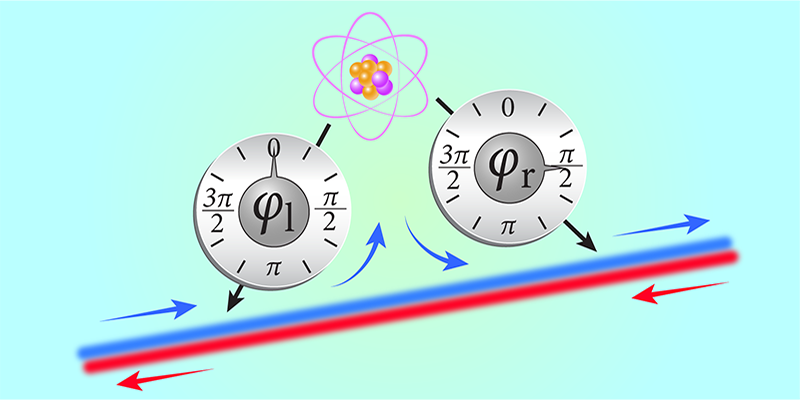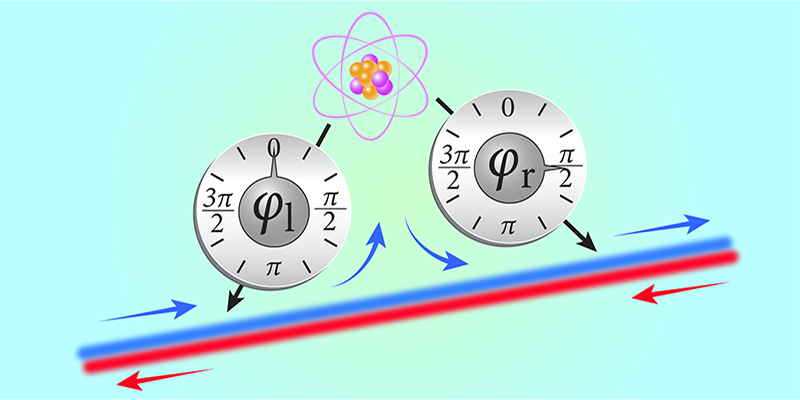Artificial Atoms Go Chiral
If a source emits a wave that scatters off an object and is then measured by a detector, the principle of reciprocity states that the measured signal will be unchanged if the source and detector switch places. This symmetry is a prevalent feature in all physical systems, but for certain applications it constitutes an obstacle. For example, to create an isolator—a gadget that allows signals to pass in one direction but not in the other—reciprocity must be broken. Such nonreciprocal devices—ones defined by preferential direction or “chirality” in their emission or absorption—are valuable in many fields. Recently, nonreciprocal devices have been implemented in the superconducting electrical circuits used in quantum computing, but all have had drawbacks. Now Chaitali Joshi and her colleagues from the California Institute of Technology have constructed a simpler nonreciprocal device: an “artificial atom” made from a superconducting circuit, which can be coupled exclusively to either left- or right-moving signals in a microwave waveguide [1]. This chiral design could be used in quantum networks to enable control over information flow between multiple artificial atoms coupled to a waveguide.
Superconducting circuits are one of the most prominent platforms for quantum computing [2]. But they would benefit from having nonreciprocal components that could help them to stay cool and route quantum information [2–5]. Previous work has demonstrated nonreciprocal devices that control the propagation of visible light using natural atoms and other single-photon emitters [3]. In that work, the light is confined to a planar waveguide that limits the polarization of the light to specific orientations. An atom or other emitter coupled to the waveguide can then be made to only emit and absorb light traveling in one direction.
However, this visible-light setup does not work for superconducting circuits and for the lower-frequency microwaves to which they couple [6]. Because natural atoms are not very flexible microwave emitters, researchers typically use artificial atoms made from superconducting components arranged in a resonant-circuit format. Like real atoms, these superconducting circuits have ground states and excited states, which can be set for a desired application. The problem, however, is that the coupling between artificial atoms and microwave waveguides does not offer the same polarization dependence as in the visible case [6]. Researchers have devised other strategies, but existing chiral interfaces for superconducting circuits tend to be bulky, complex, or limited in other ways [2].
Some recently proposed and demonstrated schemes for chirality use a “giant molecule,” which is a pair of artificial atoms coupled together [7, 8]. Each atom is connected to a waveguide at a separate point. Interference effects alter the emission and absorption of each atom, thus causing the transmission through the waveguide to be suppressed or enhanced. Joshi and her colleagues have taken this idea and simplified it such that only one artificial atom is needed as an emitter. They designed an artificial atom that couples to a 1D waveguide at multiple points separated by single-wavelength distances—realizing an extension of the giant-molecule concept in the form of a “giant atom” [9, 10].
To achieve the required interference effects using a single emitter, the researchers not only had to set the spacing between the coupling points, but also establish the phase of the coupling at each point. They achieved this by using additional superconducting artificial atoms as couplers between the emitter atom and the waveguide. Using a magnetic field, the team could tune the coupler atoms in a way that effectively controlled the coupling between emitter and waveguide. The relative phase between the modulations of the two couplers yielded the crucial phase difference that either let forward- or backward-propagating light pass through the waveguide (Fig. 1). The phase difference in modulation was easy to tune, and thus the chirality of the interaction could be easily flipped from one direction to the other.
The researchers demonstrated the properties of their device in a series of experiments. First, they measured the transmission of a weak photonic signal on resonance with the atom. This measurement showed that the coupling to forward- or backward-propagating photons reduced from strong to vanishingly small as the relative phase of the modulation signals varied. Next, the researchers increased the strength of the probe signal enough to saturate the first transition of the atom. At that point, they observed the so-called Mollow triplet, a well-known quantum-optical phenomenon, thus showing that the chirality of the interaction was not limited to working for just a single photon. Finally, they probed the transition between the first and second excited states of the artificial atom, showing that the coupling between these states could also be made chiral. They also observed how the phase of the probe photons changed depending on the state of the atom. In doing so, they realized a quantum logical gate between the atom and a photon.
A natural next step would be to show that the new chiral device can transmit more than just a simple flow of microwave photons. For example, the team could try to transfer a quantum state from one artificial atom to another and back. Such a demonstration would constitute an important step toward building large quantum networks with superconducting artificial atoms. Implementing a large network will require further suppressing the loss channels in the setup and increasing the coupling strength between the artificial atoms and the waveguide. These improvements should, however, be quite straightforward to realize.
References
- C. Joshi et al., “Resonance fluorescence of a chiral artificial atom,” Phys. Rev. X 13, 021039 (2023).
- X. Gu et al., “Microwave photonics with superconducting quantum circuits,” Phys. Rep. 718-719, 1 (2017).
- P. Lodahl et al., “Chiral quantum optics,” Nature 541, 473 (2017).
- J. I. Cirac et al., “Quantum state transfer and entanglement distribution among distant nodes in a quantum network,” Phys. Rev. Lett. 78, 3221 (1997).
- H. J. Kimble, “The quantum internet,” Nature 453, 1023 (2008).
- M. Casariego et al., “Propagating quantum microwaves: towards applications in communication and sensing,” Quantum Sci. Technol. 8, 023001 (2023).
- P.-O. Guimond et al., “A unidirectional on-chip photonic interface for superconducting circuits,” NPJ Quantum Inf. 6, 32 (2020).
- B. Kannan et al., “On-demand directional microwave photon emission using waveguide quantum electrodynamics,” Nat. Phys. 19, 394 (2023).
- A. F. Kockum, “Quantum optics with giant atoms—the first five years,” International Symposium on Mathematics, Quantum Theory, and Cryptography 125 (2020).
- B. Kannan et al., “Waveguide quantum electrodynamics with superconducting artificial giant atoms,” Nature 583, 775 (2020).





